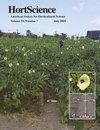提高产量的生菜单一光源照明对采后寿命没有负面影响
IF 1.5
3区 农林科学
Q2 HORTICULTURE
引用次数: 0
摘要
单一光源照明对水培莴苣生长和产量的影响已被广泛研究,但对收获后性能的研究却很有限。我们在一个室内垂直研究农场中水培了'Green Incised'和'Hydroponic Green Sweet Crisp'折叶莴苣(Lactuca sativa),其日光照积分(DLIs)为 12 或 18 mol-m-2-⋅d-1,发光二极管灯具发出的蓝光(B;400-499 nm)和红光(R;600-699 nm)的比例如下:B5:R95、B20:R80 和 B5:R95:B5:R95、B20:R80 和 B35:R65。我们推测,生物量积累会随着 DLI 的增加而增加,随着 B 光分量的减少而减少,采后寿命会随着 DLI 和 B 光分量的增加而增加。不出所料,随着 B 光比例从 5%增加到 35%,嫩枝鲜重、叶片长度和宽度、叶片数量和相对叶绿素含量(SPAD;仅 "绿色刻痕")均有所下降。将 DLI 从 18 mol⋅m-2⋅d-1 降低到 12 mol⋅m-2⋅d-1 会降低两个品种的嫩枝鲜重和叶片数。与更高的 DLI 或更多的硼光处理相比,'Green Incised'在 12 mol⋅m-2⋅d-1 的 B5:R95 条件下,叶片宽度增加了 27%,叶片长度增加了 60%。在 18 mol⋅m-2⋅d-1 的 B5:R95 条件下生长时,'Hydroponic Green Sweet Crisp'的嫩枝鲜重最大,随着 B 光照增加或 DLI 降低,嫩枝鲜重也随之降低。收获时,将每个栽培品种和处理的叶片放入蛤壳中,在 7 °C 的黑暗条件下储存,并对腐烂情况进行评估。在B35:R65和18 mol⋅m-2⋅d-1 DLI条件下生长的'Green Incised'莴苣储藏寿命最短,重复1和重复2的储藏寿命分别为9.5 d和11.4 d,比在其他处理下生长的莴苣储藏寿命分别提前了2.5至4.0 d和1.4至3.6 d。相比之下,"水培绿色甜脆 "不受光质或DLI的影响,重复1和重复2的贮藏期分别为12.6至13.3 d和13.5至14.3 d。因此,5% 至 20% 的 B 光分量和 18 mol⋅m-2⋅d-1 的 DLI 可培育出高产且贮藏期相对较长的皱叶生菜。本文章由计算机程序翻译,如有差异,请以英文原文为准。
Sole-source Lighting of Lettuce that Increased Yield Had No Negative Effect on Postharvest Longevity
The effects of sole-source lighting on the growth and yield of hydroponically grown lettuce have been extensively studied, but research of postharvest performance is limited. We grew frill-leaf lettuce (Lactuca sativa) ‘Green Incised’ and ‘Hydroponic Green Sweet Crisp’ hydroponically in an indoor vertical research farm under daily light integrals (DLIs) of 12 or 18 mol⋅m−2⋅d−1 and the following three ratios of blue (B; 400–499 nm) and red (R; 600–699 nm) light from light-emitting diode fixtures: B5:R95, B20:R80, and B35:R65. We postulated that biomass accumulation would increase with the DLI and decrease with the B light fraction, and that postharvest longevity would increase with the DLI and the B light fraction. As expected, shoot fresh weight, leaf length and width, leaf number, and relative chlorophyll content (SPAD; ‘Green Incised’ only) decreased as the proportion of B light increased from 5% to 35%. Decreasing the DLI from 18 to 12 mol⋅m−2⋅d−1 reduced the shoot fresh weight and leaf number of both cultivars. Leaves of ‘Green Incised’ were up to 27% wider under B5:R95 and 60% longer under B5:R95 at 12 mol⋅m−2⋅d−1 than those under treatments with a higher DLI or more B light. The shoot fresh weight of ‘Hydroponic Green Sweet Crisp’ was greatest when grown under B5:R95 at 18 mol⋅m−2⋅d−1 and decreased as B light increased or DLI decreased. At the time of harvest, leaves of each cultivar and treatment were placed in clamshells and stored at 7 °C in darkness and evaluated for decay. ‘Green Incised’ that grew under B35:R65 and a DLI of 18 mol⋅m−2⋅d−1 had the shortest storage life, with 9.5 d and 11.4 d for replications 1 and 2, respectively, which were ∼2.5 to 4.0 d and 1.4 to 3.6 d earlier, respectively, than the storage life of lettuce grown under other treatments. In contrast, ‘Hydroponic Green Sweet Crisp’ was not influenced by light quality or DLI and had a storage life of 12.6 to 13.3 d and 13.5 to 14.3 d for replications 1 and 2, respectively. Therefore, a B light fraction between 5% and 20% and a DLI of 18 mol⋅m−2⋅d−1 produced high-yielding frill-leaf lettuce with a relatively long storage life.
求助全文
通过发布文献求助,成功后即可免费获取论文全文。
去求助
来源期刊

Hortscience
农林科学-园艺
CiteScore
3.00
自引率
10.50%
发文量
224
审稿时长
3 months
期刊介绍:
HortScience publishes horticultural information of interest to a broad array of horticulturists. Its goals are to apprise horticultural scientists and others interested in horticulture of scientific and industry developments and of significant research, education, or extension findings or methods.
 求助内容:
求助内容: 应助结果提醒方式:
应助结果提醒方式:


